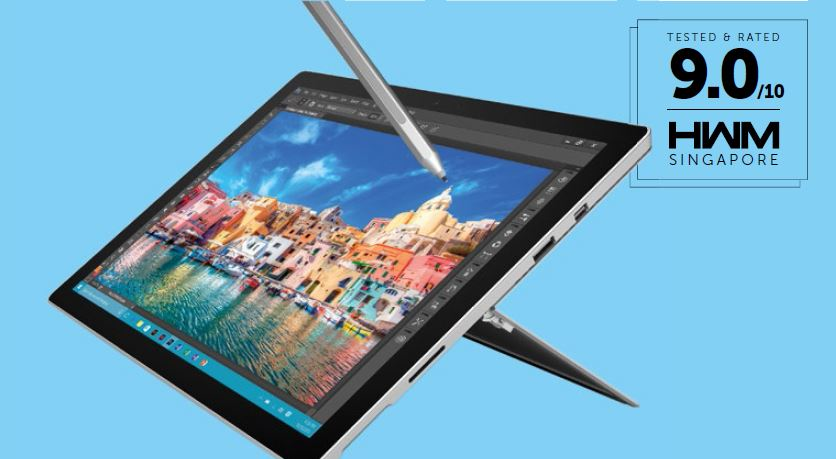An exceptional successor to the Surface Pro 3, keeping all its best aspects intact while piling on useful upgrades.



CONCLUSION
An exceptional successor to the Surface Pro 3,keeping all its best aspects intact while piling on useful upgrades.
Microsoft Surface Pro 4
The Surface Pro 4 may look a lot like the Surface Pro 3, but it enters quite a different market than its predecessor did slightly over a year ago. Back then, Microsoft still had to work to convince customers that the line between tablet and notebook was a false divide. Now, Microsoft faces a different kind of pressure – improving an already great product.What Microsoft has done is really to make subtle upgrades to nearly every aspect of the Surface Pro 3, while retaining the parts that people loved about it.
The same impeccably constructed magnesium alloy body makes a return, except that it is now thinner (8.5mm vs. 9.1mm) and lighter (786g vs. 800g) than before. But even though the length and width remains unchanged, Microsoft has managed to include a larger 12.3-inch PixelSense display that is brighter than that on the Surface Pro 3 and has an even higher resolution of 2,736 x 1,824 pixels. This maintains the same 3:2 aspect ratio as the Surface Pro 3, but boosts the pixel density up to 267ppi (from 216ppi).
The 3:2 aspect ratio is good for productivity tasks like working on documents and spreadsheets, but less ideal for entertainment purposes like watching movies. Still, the Surface Pro 4 is primarily a business device (it even ships with Windows 10 Pro), which is why Microsoft is prioritizing work applications above others.Other improvements include an upgraded 8-megapixel rear camera with autofocus, and a 5-megapixel front camera.
The front camera array actually uses a combination of the webcam and infrared cameras to support infrared facial recognition for use with Windows Hello. There are no differences compared to the Surface Pro 3 in terms of port layout and selection, although the volume rocker has now been shifted to sit beside the power button. Other than that, there is the same selection (and limitations) of just one USB 3.0 port, one mini DisplayPort connector, one microSD card slot under the kickstand, and a 3.5mm headphone jack. The reversible magnetic charging port also remains unchanged.

The volume rocker is now located at the top.
AT A GLANCE
Processor: Intel Core i5-6300U (2.4GHz, 3MB cache), Memory: 8GB LPDDR3 RAM, Graphics: Intel HD Graphics 520, Storage: M.2 256GBSSD, Price: $1,999.

CONCLUSION
An exceptional successor to the Surface Pro 3,keeping all its best aspects intact while piling on useful upgrades.
There’s actually a reason why Microsoft left everything untouched but chose to relocate the volume button. That’s because it wanted to leave the left edge of the tablet bare in order to have a suitably flat area to which you could magnetically attach the bundled Surface Pen. As it turns out, this works quite well and the magnets feel sufficiently strong without making it excessively hard to detach the pen. Perhaps it is slightly more intuitive to use the volume rocker in its previous vertical orientation, but the convenience of being able to attach the Surface Pen to the tablet’s side more than makes up for this.
Our review unit came with a sixth-generation Intel Core i7-6300U processor, 8GB of LPDDR3 RAM, and a 256GB SSD. The base model starts with an Intel Core m3-6Y30 processor, while the top model can be equipped with an Intel Core i7-6650U processor with Intel Iris Pro graphics. We’d argue that the review unit’s configuration offers the best balance between price and performance. Unless you intend to do some professional AutoCAD work, you’re not going to notice much of a difference between the Core i5 and Core i7 processors in general use.
And despite its smaller 39Wh battery, compared to the Surface Pro 3’s 42Wh juice pack, the Surface Pro 4lasted for 196 minutes in our battery tests, 16 minutes more than its predecessor – no doubt thanks to the more efficient Skylake processor. Overall, the newer tablet was around 11% faster than the Surface Pro 3 in PCMark Home, and it even managed to edge out ultrabooks like this year’s MacBook, the 13-inch MacBook Air, and the Dell XPS 13 (with a fifth-generation Intel processor).
But hardware upgrades aside, the new Surface Pen and Type Cover keyboard are a big part of why the Surface Pro 4 is such a compelling improvement. The Surface Pen now comes with 1,024 levels of pressure sensitivity, up from 256 previously. The more nuanced ability to respond to different pressures allows for a more natural writing experience, and when combined with the display’s reduced parallax distance and better touch controller, the entire experience feels quicker and better than ever.
Then there’s the Type Cover keyboard, which now comes with familiar chiclet-style keys found on the keyboards of many full-fledged notebooks. The increased key travel distance and key spacing combine for a far more enjoyable typing experience. On top of that, the trackpad is now a larger, glass affair, which is a lot smoother than previous versions. Finally, Microsoft has also used a different material for the keyboard to make it more resistant to grease stains and smudges.

The front camera array supports infrared facial recognition for Windows Hello.























